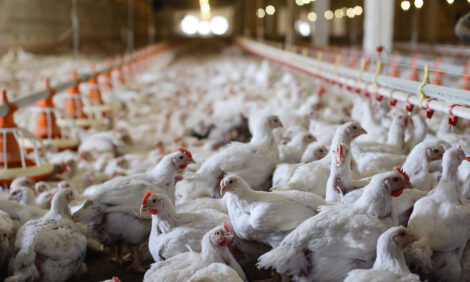



Live Priming Followed by Inactivated Booster Advised for IB Control
Vaccination for infectious bronchitis (IB) with a protocol that includes priming with at least one live vaccine followed by boosting with an inactivated vaccine was advised at a workshop organised by MSD Animal Health and held in Birmingham, England.Infectious bronchitis (IB) virus continues to plague the poultry industry because it is highly infectious, persistent and disseminates fast, Aris Malo, DVM, global technical director for poultry, MSD Animal Health, said at a workshop held in Birmingham, England.
IB is also an RNA virus, which is subject to mutations and recombination. As a result, Dr Malo added, new IB viruses emerge often.
In broilers, the consequences of IB include poor weight gain and feed efficiency, higher condemnation at processing, secondary infections and increased antibiotic use, although mortality is possible if the IB strain is the type that affects the kidneys, the veterinarian said. In layers and breeders, IB can cause problems including false layers, respiratory signs and decreased egg production and quality.
New Vaccines Unnecessary


When new serotypes of IB emerge, amino acid changes occur in the S1 part of the virus’s spike genome, but the rest of the virus genome remains unchanged, Dr Malo explained. “This is why cross-protection against IB viruses can be achieved with IB vaccines of another serotype – an approach we call a Protectotype – and why it is not necessary to develop a new vaccine for every new IB strain that pops up.”
Sjaak de Wit, PhD, of the Animal Health Service, Deventer, the Netherlands, agreed that producers can get good protection using existing vaccines and emphasised that the most effective strategy involves one or two live, primer IB vaccines followed by an inactivated IB booster vaccine.
He cited published studies by other investigators demonstrating that layers not vaccinated against IB had over a 70 per cent drop in egg production. In contrast, vaccination at three and 16 weeks of age with an inactivated M41 IB vaccine, and without a live primer, resulted in egg-production declines of about 30 per cent. On the other hand, a protocol employing a live IB Massachusetts-strain vaccine at three weeks of age, followed by a different live IB Massachusetts-strain vaccine at 16 weeks of age, resulted in a 10 per cent drop.
No decline in egg production occurred in birds vaccinated once with a live IB vaccine at three weeks of age followed by an inactivated IB vaccine at 15 weeks of age.
“The best results were achieved when live priming was followed by boosting with an inactivated vaccine,” Dr de Wit said.
Low Antibodies = Poor Protection
More recent studies conducted by Dr de Wit and colleagues have yielded similar results. They tested four IB vaccine combinations against four Chinese Q1 IB strains obtained from Latin America. The primer was either a live, Massachusetts (Ma5) IB strain or a live Ma5 plus a live IB 4/91 variant, which is prevalent in Europe, followed by killed boosters with IB M41 alone or with IB D274.
The lowest level of virus-neutralising antibodies – which correlate with poor protection – occurred when only a live Massachusetts strain (Ma5) vaccine and a boost with inactivated M41 was used. On average, a broad-spectrum live-vaccine priming regimen (Massachusetts and variant IB) followed by a multivalent inactivated IB vaccine yielded the best results and highest level of neutralizing antibodies, Dr de Wit said.
He pointed out that live IB vaccines provide good protection but for a short time, while inactivated IB vaccines provide longer–term protection. Broilers need more immediate protection, while layers and breeders need protection for a longer time – that is why the broad spectrum vaccination schedule is likely to work better for long-lived birds, he said.
“There’s no guarantee when it comes to IB,” Dr de Wit said, but generally, “broad, live priming induces more virus neutralising antibodies against more strains, and more strains in an inactivated vaccine might help induce more neutralising antibodies against more strains, even when the antigens are heterologous to the challenge virus.”
The results will depend on the strains used, the amount and quality of antigen given as well as the adjuvant in vaccines and proper vaccine application.

Recommends IB Testing
Dr de Wit advocated testing to determine what strains are circulating and to enable wise IB vaccine protocol choices.
Tibor Cserep, DVM, MRCVS, a technical manager with MSD Animal Health in the UK, said state–of–the–art IB testing provided to MSD Animal Health poultry customers since 2009 was yielding practical information that producers have used in the field to improve results.
The use of polymerase chain reaction (PCR) testing, for instance, can detect IB viruses that would have tested negative using older testing methods. Molecular diagnostics help identify the IB strains that are circulating, and enable vaccination programmes to be adjusted so that poultry producers can achieve better results.
In the UK, the testing has demonstrated multiple QX strain field viruses within the same flocks. The QX vaccine virus, however, has not been found by testing. In addition, trials with vaccine combinations have demonstrated that using both Ma5 and IB 4/91 vaccines protect against QX viruses, he said.
MSD Animal Health has also learned that spray administration of the IB 4/91 vaccine leads to better vaccine uptake.
“In high-challenge environments, switching from drinking water to spray administration could strengthen the vaccination programme,” Dr Cserep said.
Testing is provided through x-OvO, a specialist avian diagnostic company headquartered in the UK, and the Institutio Zooprofillattico Sperimentale, Italy.
Dr Cserep emphasised the importance of proper sampling for testing in flocks experiencing an IB outbreak. Ten tracheal or cloacal/caecal swabs per airspace should be taken during the acute phase of disease, though cloacal/caecal swabs are preferred for layers. Proper completion of forms is important. If samples and swabs are submitted properly, the turnaround time for results is a maximum of three weeks, he said.
"IB is a moving target, but with testing and the use of the Protectotype approach to management, producers can achieve broad protection against known and possibly unknown IB viruses,” he added.
Further Reading
|
| - | Find out more information on infectious bronchitis by clicking here. |
May 2012










